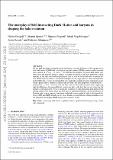The interplay of self-interacting dark matter and baryons in shaping the halo evolution
Author(s)
Despali, Giulia; Sparre, Martin; Vegetti, Simona; Vogelsberger, Mark; Zavala, Jesús; Marinacci, Federico; ... Show more Show less
DownloadAccepted version (2.716Mb)
Terms of use
Metadata
Show full item recordAbstract
© 2019 The Author(s) Published by Oxford University Press on behalf of the Royal Astronomical Society. We use high-resolution hydrodynamical simulation to test the difference of halo properties in cold dark matter (CDM) and a self-interacting dark matter (SIDM) scenario with a constant cross-section of σ T /m ' ‡ = 1 cm 2 g '1. We find that the interplay between dark matter self-interaction and baryonic physics induces a complex evolution of the halo properties, which depends on the halo mass and morphological type, as well as on the halo mass accretion history. While high-mass haloes, selected as analogues of early-type galaxies, show cored profiles in the SIDM run, systems of intermediate mass and with a significant disc component can develop a profile that is similar or cuspier than in CDM. The final properties of SIDM haloes - measured at z = 0.2 - correlate with the halo concentration and formation time, suggesting that the differences between different systems are due to the fact that we are observing the impact of self-interaction. We also search for signatures of SIDM in the lensing signal of the main haloes and find hints of potential differences in the distribution of Einstein radii, which suggests that future wide-field survey might be able to distinguish between CDM and SIDM models on this basis. Finally, we find that the subhalo abundances are not altered in the adopted SIDM model with respect to CDM.
Date issued
2019-01Department
Massachusetts Institute of Technology. Department of Physics; MIT Kavli Institute for Astrophysics and Space ResearchJournal
Monthly Notices of the Royal Astronomical Society
Publisher
Oxford University Press (OUP)
ISSN
0035-8711
1365-2966